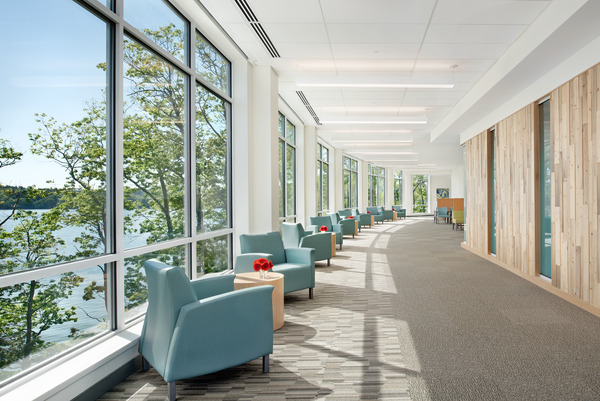Design is more than aesthetics; it has the power to heal. Spaces around us impact our well-being significantly.
The concept of “Design for Healing” centers on creating environments that promote physical, emotional, and mental recovery. It’s about harnessing the potential of design to improve health outcomes and enhance the quality of life. Imagine entering a space that calms your mind and soothes your soul, a place where the very walls seem to chip away at the stresses of the day.
That’s the essence of design for healing. This approach goes beyond mere decoration, tapping into the psychology of color, the ergonomics of furniture, and the tranquility of well-placed art to foster an atmosphere conducive to healing. Whether it’s a hospital room designed to promote recovery or a living space adjusted for serene living, the right design can make a world of difference. As we explore the depths of this transformative concept, let’s consider how our surroundings influence our journey to wellness. Join us as we delve into the heart of design for healing, where every element is purposeful, and every space is a sanctuary for the senses.
The Essence Of Healing Environments
Spaces designed for health impact our recovery. A well-crafted environment can speed up healing. This is the core of healing environments. They are calm, and comforting, and promote wellness.
Key Characteristics
Healing spaces share common features. They are bright, open, and quiet. Clean lines and uncluttered spaces reduce stress. The colors are soft and soothing. Art and design elements inspire peace.
The Role Of Nature
Nature plays a vital part in healing. Natural light boosts mood and sleep. Plants and water features bring life indoors. Views of nature help patients relax and feel hopeful.
Related Article: Personal Space Design: Crafting Your Comfort Zone

Credit: e4harchitecture.com
Related Article: Green Urban Design: Transforming Cities for a Sustainable Future
Principles Of Therapeutic Design
Creating spaces that heal is an art rooted in science. Therapeutic design taps into elements that soothe the senses, calm the mind, and promote wellness. It’s about crafting environments that support recovery and enhance well-being. Key principles guide architects and designers in this quest to create spaces that not only look good but feel good too.
Incorporating Natural Elements
Bringing the outdoors inside plays a big role in healing design. Plants, water features, and natural light can make a space feel alive. These elements connect us to nature, which is known to speed up healing. Large windows, indoor gardens, and images of nature all work to bring a sense of the outside world into healing spaces.
Ensuring Privacy And Comfort
A sense of control over one’s environment is crucial for comfort and privacy. Private rooms with space for family help. Soft furnishings and adjustable lighting let people personalize their space. Such details matter when creating a healing environment. They offer a retreat from the stress of the outside world and provide a sanctuary where one can rejuvenate in peace.
Case Studies: Successful Healing Spaces
Welcome to our deep dive into Case Studies: Successful Healing Spaces. We explore how design boosts healing. Our focus? Healthcare facilities and community spaces. Let’s see what works.
Healthcare Facilities
Design plays a key role in patient recovery. Bright, airy rooms help. So does nature. Patients in rooms with window views get better faster. They need less pain medicine too. Let’s look at some real places.
- Maggie’s Centres: These are special cancer care spaces. They feel at home, not in a hospital. Lots of light, wood, and greenery. Patients feel calm and hopeful here.
- Children’s Hospital: Color and play areas matter. Kids forget they are sick. They play and heal. Bright walls and fun designs are key.
Community And Public Spaces
Healing doesn’t just happen in hospitals. Parks, gardens, and public art heal too. These spaces invite everyone. They offer peace and beauty. Let’s explore examples.
- Healing Gardens: Places like the High Line in New York. Once an old train track. Now a beautiful walkway with plants and art. People walk, relax, and find peace.
- Public Art: Murals and sculptures in public places. They tell stories. They make us stop and think. Art heals the mind and soul.
Design for healing brings hope and comfort. It’s about more than just buildings. It’s about creating spaces where everyone feels better.
Design Techniques For Emotional Well-being
Emotional well-being shapes our daily experiences. Design plays a crucial role in crafting spaces that promote healing and comfort. Below, explore techniques that leverage design to enhance emotional well-being.
Color Psychology
Color Psychology
Colors influence moods and feelings. Designers use color psychology to create a calming environment. Here are key colors and their effects:
- Blue – Calms the mind and aids concentration.
- Green – Promotes tranquility and health.
- Yellow – Stimulates happiness and energy.
- Pink – Evokes warmth and comfort.
Choosing the right colors can transform a space into a healing sanctuary.
Lighting and Acoustics
Lighting And Acoustics
Proper lighting and acoustics are vital. They shape the room’s mood and energy. Consider these aspects:
| Natural Light | Artificial Light | Acoustics |
|---|---|---|
| Boosts Vitamin D | LEDs mimic daylight | Soft materials absorb sound |
| Improves sleep | Warm tones for relaxation | Design to minimize echo |
Integrating these elements fosters an atmosphere conducive to emotional healing.
Integrating Technology In Healing Spaces
Indeed, integrating modern technology enhances healing spaces, supporting comfort and recovery. Designing for healing embraces such innovations to improve patient care.
Integrating technology in healing spaces can transform patient experiences. The blend of design and innovation offers comfort and promotes wellness. Let’s explore how tech integration touches lives in these spaces.
Innovative Materials
Healing spaces now embrace materials that do more than look good. They have smart functions too. Imagine walls that clean the air, floors that kill bacteria, and surfaces that change color for mood. These materials aren’t just about aesthetics; they’re active health agents. They create cleaner, safer environments for recovery and care.
Smart Environmental Controls
Control at your fingertips. That’s what smart environmental systems offer in healing spaces. Patients can adjust light, temperature, and even window shades with a simple touch. These systems learn and adapt to preferences, ensuring comfort around the clock. It’s about personalizing the healing journey, and giving control back to those who need it most.
Challenges And Future Directions
Design for Healing faces both challenges and future directions. Let’s dive deeper.
Overcoming Barriers
Designing for healing isn’t easy. We see barriers. Costs. Regulations. Technology.
- Costs can be high. But smart choices help manage them.
- Regulations are strict. Designers must know these rules well.
- Using technology wisely opens new paths for healing designs.
Teams work together to beat these challenges. Success comes from teamwork and smart planning.
Trends To Watch
New trends shape the future of healing design. These are exciting times.
- Green spaces inside buildings promote health.
- Smart tech helps patients and staff.
- Designs that support mental health are growing in need.
These trends guide us to better healing spaces. Spaces that heal both the body and mind.

Credit: www.healingdesign.com
Related Article: Green Building Techniques: Eco-Friendly Design for Modern Living
Conclusion
Embracing the power of design can truly transform a space into a sanctuary for healing. Every detail counts, from colors to layouts. Think of the comfort a well-designed room brings. It’s not just about looks; it’s about how spaces feel.
The design doesn’t just beautify; it supports wellness and recovery. So, let’s create environments that heal. Remember, good design is good health. Your next step could be a leap towards healing, just through thoughtful design. Let’s make our spaces places where healing thrives.
You may also read: Urban Planning Trends: Transforming Cities for a Sustainable Future

Pingback: Green Urban Design: Transforming Cities for a Sustainable Future - SpaceArc